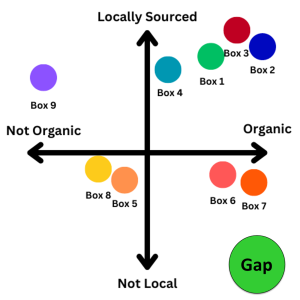Chapter 6 – Using Research to Find Opportunities
Learning Objectives
- Discover sources of opportunity using industry data
- Examine consumer trends for opportunities
- Conduct analysis on competitors within an industry
- Understand how to create a perceptual map
- Use social media research to find opportunities in the market
Industry Sources of Opportunity
As you explore ideas for your business venture, consider what industry your product or service operates in. An industry is a group of companies that are related based on their primary activities. For example, Delta, American Airlines, Spirit, Frontier, and United all belong to the airline industry. Conducting research on industry trends may provide valuable insight that will spark an idea for your product. An excellent source for industry information is the business reference section of your college library, here’s a link to NC State’s Business Research page.
Industry sources reveal knowledge about a specific industry from the perspective of identifying unmet needs or areas for improvement within that industry. For example, Airbnb reshaped the hotel industry by connecting travelers with property owners, so that the travelers could rent the property when the owner was not using it. As Airbnb has grown, the company has made improvements to their offerings in meeting the needs of the traveler’s demand based on property location and in categorizing the supply (the homeowner’s property) for increased efficiency, meeting the needs of both the property owner and the traveler. Researching specific industries from supply and demand perspectives, and noticing unused supplies, as we saw in the Airbnb example, also applies to other industries.
Almost every industry is worth investigating from the perspective of identifying unused resources or extra resources that could be restructured for what are known as a shared economy or a gig economy. A shared economy considers that there are times when an asset in not in use. This down time when the asset is not in use provides an opening for someone else to use that asset, like Airbnb. Other companies, like Uber, Lyft, DoorDash, and Postmates, support the gig economy in aligning a person’s choices for when they want to work with the flow of the work demand. A gig economy is an open or fluid market system with temporary positions made up of independent short-term workers. In these examples, we can see the alignment of supply and demand. The entrepreneurial opportunity happens in providing a platform to assist in connecting the supply and demand.
One industry that has excelled in change management post-pandemic is healthcare, particularly telemedicine. By leveraging advancements such as virtual consultations, phone screenings, and remote diagnostics, telemedicine has expanded access to urgent care for patients with limited medical services. According to the Centers for Disease Control and Prevention (CDC), telemedicine usage among office-based physicians increased by 71.1% (CDC, 2023). While the industry faces challenges, public opinion continues to shift in favor of online healthcare, with projections indicating that by 2026, 25–30% of all medical visits in the U.S. will be conducted remotely (McKinsey & Company, 2023).
Beyond healthcare, AI and cloud computing have also evolved significantly. With increased scalability and accelerated machine learning capabilities, these technologies continue to reshape industries. The global AI market is projected to reach a market cap of $1.8 trillion by 2030, while cloud computing is expected to grow to $2.5 trillion within the same timeframe (SCNSoft, 2023; McKinsey & Company, 2023). These advancements highlight how industries are not only adapting to change but actively driving innovation in a rapidly evolving digital landscape.
Another consumer trend is the demand for affordable housing. One solution involves offering more affordable “tiny homes” that make home ownership more accessible (see figure below). As one entrepreneurial opportunity materializes into a new product, spin-off ideas may also arise. The tiny home concept attracted the attention of groups that assist homeless veterans. The Veterans Community Project in Kansas City, has developed a community of forty-nine tiny homes for homeless veterans and the project is so successful that more than 500 cities around the country are building tiny home housing projects for veterans there.

Link to Learning: Euromonitor International
You can find a substantial amount data on consumer trends doing a quick Google search; however, one good resource is Euromonitor International.
Entrepreneurs who have a strong understanding of the industry in which they intend to operate and consumer trends should feel more confident in their potential for success when creating a product that aligns with both.
Competitor Sources of Opportunity
A competitive analysis should provide the entrepreneur with information about how competitors market their business and ways to penetrate the market by entry through product or service gaps in areas that your competitors do not serve or do not serve well. More importantly, competitive analysis helps the entrepreneur develop a competitive edge that will help create a sustainable revenue stream. For example, a big company like Walmart primarily competes on price. Small companies typically cannot compete on price, since the internal efficiencies and volume sales available to large corporations like Walmart are not available to small companies, but they may be able to compete successfully against Walmart on some other important variable such as better service, better-quality products, or unique buying experiences.
Perceptual mapping is a visual tool that can help entrepreneurs define which product attributes are most important to customers, the products that are currently offered, and find the gap where an opportunity may exist. For example, food box delivery services offer a convenient way for customers to purchase the ingredients and recipes needed to prepare meals at home without going to the grocery store. Let’s assume that two important attributes of food delivery boxes are organic and locally-sourced ingredients.
When creating a perceptual map, you want to plot out each company and where they fall along each axis. See the figure below which represents food delivery box competitors.

After examining the perceptual map, are there any gaps in the offerings? Within those gaps, can you find opportunities? In the perceptual map below, we see that there are not many competitors who are offering organic ingredients that are not locally sourced. By conducting research, we can determine if this combination of attributes is appealing to potential customers, especially if it improves the quality of the ingredients or reduces the price of the delivery boxes. If our research shows that there is indeed a need for delivery boxes that meet this criteria, then we may decide to explore this opportunity further.

Link to Learning: Perceptual Mapping
Visit Appinio to learn more.
Social Media Sources of Opportunity
For almost all new business ventures, two key issues related to research are time and money. Social media research can offer some opportunities to overcome these concerns. Ray Nelson, writing for Social Media Today, reports several ways that social media can provide speedy, low-cost market research: tracking trends in real-time, helping the entrepreneur “learn the language” of their potential customers, discovering unnoticed trends by engaging consumers, and performing market research using a very cost-efficient means. If the entrepreneur can perform social media research on their own, the cost will primarily be in terms of time. But the time it will take to conduct research through social media platforms such as Facebook or Instagram is usually well spent. This research should include learning the unique selling proposition of competitors, understanding their competitive advantage, and identifying what the customer values, which can be rather difficult. For example, before Amazon recognized that people are busy, were we aware that we wanted faster check-out processes for making purchases? Or were we aware that we wanted the package delivered to our home to be easier to unwrap? And yet, if we asked Amazon shoppers what they value in shopping at Amazon, we will receive answers that support an easier and faster process.
One way to use social media research is by reading customer reviews on companies related to your entrepreneurial venture to find out what customers like and don’t like. Can you find a trend in the negative reviews to create a product that better meets the needs of customers?
Project Focus
This module presented several ideation techniques to help generate ideas for your project. Did you use any of them? Which ones were successful / unsuccessful? How can you use these techniques for future projects or in your career?
Attribution
This work builds upon materials originally developed by OpenStax in their publication “Entrepreneurship,” which is licensed under CC BY 4.0. Additionally, original content in the section Industry Sources of Opportunity was contributed by Riley Culver and is used with permission.
References
- Centers for Disease Control and Prevention (CDC). (2023). “Telemedicine use among office-based physicians.” Retrieved from https://www.cdc.gov/nchs/products/databriefs/db493.htm
- SCNSoft. (2023). “The Future of Telemedicine Adoption.” Retrieved from https://www.scnsoft.com/healthcare/future-of-telemedicine-adoption
- McKinsey & Company. (2023). “In Search of Cloud Value: Can Generative AI Transform Cloud ROI?” Retrieved from https://www.mckinsey.com/capabilities/mckinsey-digital/our-insights/in-search-of-cloud-value-can-generative-ai-transform-cloud-roi
a group of companies that are related based on their primary activities
when assets are not in use, it provides an opportunity for someone else to use that asset
an open or fluid market system with temporary positions made up of independent short-term workers
a visual tool that can help entrepreneurs define which product attributes are most important to customers, the products that are currently offered, and find the gap where an opportunity may exist

